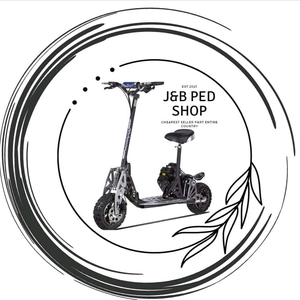Search
1/1
₱130.00
Pinion 7teeth for bigchain gas scooter affordable
Sold by J&B Ped shop
9 sold
Select options
Select
Shipping
From ₱36.00
Est. delivery by Apr 20 - Apr 23
Specifications

J&B Ped shop
63 items
Shop performance
Better than 88% of other shops
Ships within 2 days
85%
Responds within 24 hours
95%
About this product
Warranty TypeNo Warranty
Product description

A 7-tooth pinion gear for a large chain typically refers to a small gear used in a drive system, meshing with a heavy-duty chain. This setup is common in applications such as minibikes, go-karts, ATVs, or industrial machines requiring robust power transmission. Here’s a breakdown of its features and considerations:
Key Characteristics:
1. Teeth Count (7 Teeth):
• A low number of teeth indicates a smaller gear diameter, which provides high torque but lower speed.
• Often used in applications requiring initial power for acceleration or climbing.
2. Chain Type:
• The term “big chain” likely refers to a heavy-duty chain such as #428, #530, or other industrial-grade chains.
• Ensure the pitch (distance between chain pins) matches the pinion gear.
3. Material:
• Pinions are usually made of hardened steel or similar durable materials to handle the stresses of heavy loads.
4. Bore and Mounting:
• Check the bore size to ensure it fits the output shaft of your engine or motor.
• May include set screws or a keyway for secure mounting.
5. Application:
• Used for power transfer in high-torque systems.
• Common in small engine drive systems, dirt bikes, or go-karts needing high torque.
Advantages of a 7-Tooth Pinion:
• High Torque Output: The smaller size increases torque for pulling or climbing.
• Durability: Designed to handle heavy-duty chains in rugged conditions.
• Compact Size: Ideal for systems where space is limited.
Considerations:
1. Gear Ratio:
• Pairing this pinion with a larger driven sprocket will amplify torque while reducing speed.
• Calculate the gear ratio by dividing the driven sprocket teeth by the pinion teeth (e.g., 7:35 for a 1:5 ratio).
2. Chain Compatibility:
• Ensure the chain pitch, roller diameter, and width match the gear.
3. Lubrication:
• Proper lubrication extends the life of both the pinion and the chain.
4. Wear and Tear:
• Smaller pinions can wear out faster due to higher stress on fewer teeth.
Videos for this product
Explore more from J&B Ped shop

4.7
37sold
₱298.40
₱523.50


4.8
13sold
₱2,398.00
₱2,698.00

【In stock】TANZU 21V Lawn Mower Rechargeable Grass Cutter Household Electric Grass Trimmer reel mower
4.4
33sold
₱2,320.00
₱2,698.00


![[COD] Electric Cordless Grass Trimmer Grass Cutter Lawn Mower with 998V Battery Rechargeable](https://p16-oec-sg.ibyteimg.com/tos-alisg-i-aphluv4xwc-sg/1260d7348f7b48818f2a2c25ab433ff0~tplv-aphluv4xwc-crop-webp:1600:1600.webp?dr=15592&from=2378011839&idc=maliva&ps=933b5bde&shcp=e1be8f53&shp=8dbd94bf&t=555f072d)
4.9
10730sold
₱911.54
₱2,599.00

4.7
23sold
₱688.98
₱2,588.00

No more products
Open TikTok















![BBA TD40 2 Stroke Portable Shoulder Grass Cutter / Brush Cutter [40.2CC] w/ Accessories (Based on Kawasaki TD40 Grass Cutter 2 Stroke)](https://p16-oec-va.ibyteimg.com/tos-maliva-i-o3syd03w52-us/ca51b3b0b60b446c95c1eccb5dd52de4~tplv-o3syd03w52-crop-webp:1000:1000.webp?dr=15592&from=2378011839&idc=maliva&ps=933b5bde&shcp=e1be8f53&shp=8dbd94bf&t=555f072d)


![[Ready Stock] 28mm 9 spline Trimmer Gearhead Gearbox Brushcutter Grass Strimmer Brush Cutter Gear Head Mower Spare Part Gardening Tool Repair trimming and filling machine accessories](https://p16-oec-va.ibyteimg.com/tos-maliva-i-o3syd03w52-us/5c293db0d15b42d182d801332660a344~tplv-o3syd03w52-crop-webp:800:800.webp?dr=15592&from=2378011839&idc=maliva&ps=933b5bde&shcp=e1be8f53&shp=8dbd94bf&t=555f072d)





